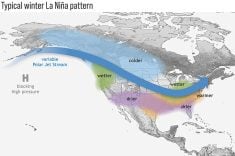Low commodity prices and the impact of declining government farm support are putting the brakes on prairie farmland prices, the Farm Credit Corporation reported last week.
The Regina-based crown corporation said average farmland prices across Canada increased 2.3 percent during the six months ending July 1998.
But in most areas of the West, price increases were far less or non-existent.
“I think a key factor here is low commodity prices,” Darrel Doepker of the FCC appraisal services said in an interview from Regina. “There is less net income, higher costs and little money to buy land.”
Read Also

Canadian Food Inspection Agency extends chronic wasting disease control program consultation deadline
Date extended for consultation period of changes to CWD program
He said part of the issue is that prairie farmers this year are feeling the effects of being forced to pay the full freight on their grain. The Crow Benefit subsidy was taken away in 1995 but this year’s lower prices for the first time are exposing the full impact.
“I think farmers are finally feeling the full effects of the end of the freight subsidy and it means less money and maybe less interest in buying grain land.”
Manitoba, with the most balanced agricultural economy in the West, was least generally affected.
The most robust farmland market in the West was in Alberta, which recorded an average 4.9 percent increase over the six months.
However, it is a misleading average, reflecting strong prices in south and central Alberta where irrigated and special crop lands are in demand.
FCC analysts said much of the demand flows from expectations that a new potato processing plant in Taber will increase demand for that crop.
Expansion of Calgary into rural lands, and the pressure on surrounding lands for acreages, also influenced the overall average.
However, in more grain and traditional farm-dependent areas, land values were soft. “The north experienced less optimism and weak-to-stable prices,” said the FCC report.
In Manitoba, where average land values rose 2.7 percent, the FCC said cereal land prices remained stable and there was some increase in demand for land in areas where crop diversification is happening.
Saskatchewan’s land prices have remained stuck at last winter’s levels. “Purchasers are cautious as a result of lower grain prices,” said the analysis. “Activity in the land market has slowed down in the last six months. Land prices have leveled off at current levels.”
The hardest hit province has been British Columbia, where average land prices have declined 2.5 percent.
The FCC said it is because of lower prices for fruits and vegetables and a “generally weakening” B.C. economy.














